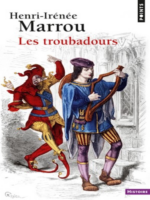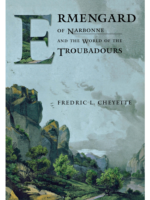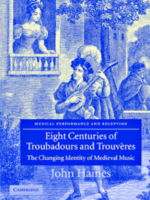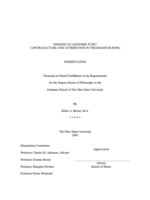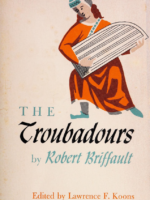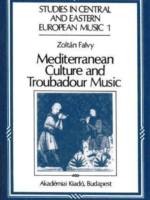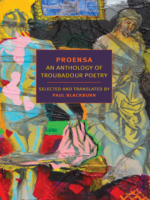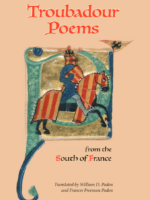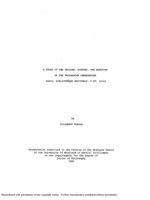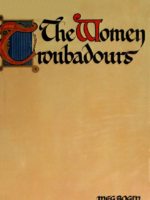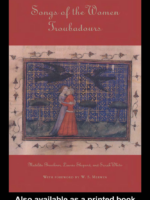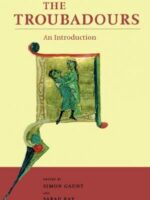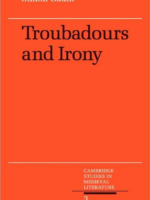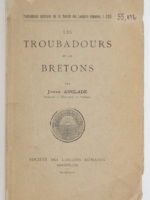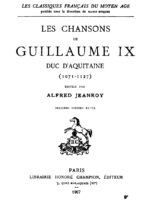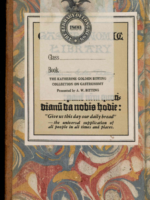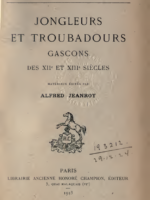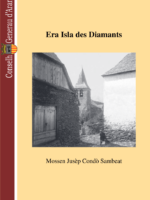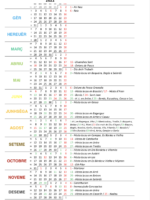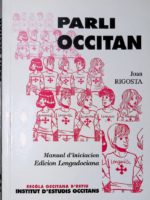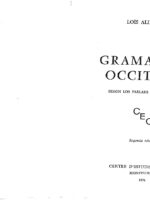Recommended Books
-
Les Troubadours
0,00 €Il serait temps de nous défaire enfin de ce poncif du troubadour errant, la guitare au côté, égayant de ses ballades les longs loisirs des tristes châteaux gothiques. C’est à cette image conventionnelle et fade que Henri-Irénée Marrou entend substituer la véritable identité et histoire des troubadours, en analysant plus généralement la “renaissance” du XIIe siècle.C’est à cette époque, en pays d’Oc, que les troubadours ont inventé l’amour, le mot comme la chose. C’est l’idéal quasi mystique de l’amour courtois qu’ils célèbrent dans leurs chansons, amour humain bien réel qui se trouve cependant presque élevé à la dignité d’un culte.La première édition de cet ouvrage date de 1961.Henri-Irénéee Marrou (1904-1977) est un des grands historiens de l’Antiquité tardive, spécialiste d’Augustin et de l’augustinisme ; a notamment publié au Seuil, L’Eglise de l’Antiquité tardive (1985) et Saint Augustin et l’augustinisme (2003).
-
Les troubadours. Une histoire poétique
0,00 €Les troubadours sont, au XIIe siècle, les auteurs, immensément admirés, des plus anciennes chansons d’amour composées dans une des langues nouvelles de l’Europe, la langue d’oc. Le tremblement du désir et celui de la crainte, la ferveur et la frustration, la jalousie et la jouissance, tout cela ils l’ont dit de façon si nouvelle et si intense que leurs chansons résonnent encore dans les mots d’amour d’aujourd’hui. Le beau livre de Michel Zink rend sa fraîcheur à cette poésie vieille de neuf siècles en la suivant dans ses méandres, en disant au fil des poèmes, qu’il cite en grand nombre, juste ce qu’il faut pour qu’elle nous parle, pour qu’elle nous enchante et pour qu’elle vive en nous.
-
Ermengard of Narbonne and the World of the Troubadours
0,00 €Ermengard of Narbonne. Even to specialists in the history of the Middle Ages her name is hardly known. Eleanor of Aquitaine, who was wife to two kings and the mother of three more? Yes, there is a name-and a story-to conjure with. Countess Marie of Champagne, Eleanor’s daughter by King Louis VII of France, patron of Chretien de Troyes, the poet who in- vented the Arthurian romance? She too is better known, if only because of the writers who thronged to her court. Ifwe know anything about the Middle Ages we have at least heard of King Richard the Lionheart and his brother King John, who was forced to grant the Magna Carta at Runnymede, both of them sons of Queen Eleanor. We have also surely heard of the mythical King Arthur and his Round Table, of Lancelot and Guinevere, of the quest for the Holy Grail, all of them largely the creation of Chretien. Ermengard, however, has fallen off the historical map.
-
Eight Centuries of Troubadours and Trouveres: The Changing Identity of Medieval Music
0,00 €From the medieval chansonniers to contemporary rap renditions, this book traces the changing interpretation of troubadour and trouv?re music, a repertoire of songs which have successfully maintained public interest for eight centuries. A study of their reception, therefore, serves to illustrate the development of the modern concept of “medieval music”. Important stages in their evolution include sixteenth-century antiquarianism; the Enlightenment synthesis of scholarly and popular traditions; and the infusion of archaeology and philology in the nineteenth century, leading to more recent theories on medieval rhythm.
-
Singing to another tune: contrafacture and attribution in troubadour song
0,00 €“Singing to another tune” is from Las Leys d’amors (The Laws of Love), a poetic treatise compiled by Guilhem Molinier in the first half of the fourteenth century. Guilhem’s phrase pertains to a compositional technique known to modern scholars as contrafacture, in which the troubadour fashions new lyrics after the poetic structure of a preexistent song, thereby allowing his work to be sung to the earlier melody. The technique of contrafacture is documented not only by Guilhem and contemporaneous theorists but also by the troubadours themselves, who on a number of occasions acknowledge composing a poem “el so de,” or “to the tune of” another composer. Both theory and practice demonstrate that structural imitation came to be most closely associated with several specific genres, including the sirventes (moralizing piece), tenso (debate song), coblas (song of few strophes), and planh (lament), their poetic structures commonly modeled after those of the canso, the dominant genre of troubadour composition. Despite abundant structural indications of contrafacture within the troubadour repertoire, melodic traces of the practice are surprisingly scant. Confirmation of melodic borrowing depends upon the preservation of a model and its contrafactum with their concordant musical readings, yet the small proportion of surviving troubadour melodies (with only one in ten lyric texts transmitted with its tune) poses a significant impediment to melodic corroboration. Only three sirventes have been preserved with melodies that duplicate those of preexistent cansos. In the remaining instances in which a sirventes, tenso, or other imitative type is preserved with a melodic unicum, scholars of troubadour song have tended to maintain that, absent melodic corroboration, the tune must be presumed original rather than borrowed. In view of the sparseness of the musical record, however, one should give consideration to an alternate interpretation, namely that the tune preserved exclusively with a given troubadour’s sirventes and thereafter transmitted as his invention may actually have been borrowed from a preexistent canso whose melody is no longer extant in its original setting. Isolating viable structural models for such suspected contrafacta allows the possibility of reascribing potentially borrowed melodies to their original composers. The study of contrafacture can thus lead us to question the received attributions of a number of tunes, thereby posing a challenge to the readily made assumption that the manuscript rubrics consistently pertain to both text and melody. By examining several suspected cases of contrafacture within a web of relevant indices– e.g., generic norms, intertextual correlations, socio-historic context, rhetorical motivation, transmission, and melodic style– we gain greater insight into a compositional technique that indelibly marked the art of the troubadours.
-
The Troubadours
0,00 €Combining extraordinary learning with grace of style, this volume provides the first comprehensive work in English on the poetic heritage of the medieval troubadours and the particular impact of the troubadour tradition on Italian and English verse. The songs of the troubadours with their intense lyricism “answered the mood of a feudal society newly awakened to a sense of its native uncouthness by contact with the luxury of the Orient.”
-
Mediterranean culture and troubadour music
0,00 €Mediterranean Culture and Troubadour Music by Zoltan Falvy. The volume gives an account of the origins of troubadour music and the development of European secular music. It focuses on the Spanish cantiga manuscript and the troubadour manuscript group. A significant part of the book deals with the Arab thesis modifying the theory by asserting that Arabic poetry was but one of the mediterranean influences on the troubadours. In an important chapter the author examines with musical orientation the social history of the 13th century period of Alphonse the Wise. A special chapter is de-voted to the clarification of the role of the heretic movements. The stylistical analysis of all the extant melodies of Peire Vidal and Gaucelm Faidit brings out the interesting discovery that troubadour music has archaic features that may be close to European folk music. Zoltan Falvy’s book has a completely new approach to troubadour music demonstrating that court music adapted to court poetry has a structure independent of the poem.
-
Proensa: An Anthology of Troubadour Poetry
0,00 €It was out of medieval Provence – Proensa – that the ethos of courtly love emerged, and it was in the poetry of the Provençal troubadours that it found its perfect expression. Their poetry was also a central inspiration for Dante and his Italian contemporaries, propagators of the modern vernacular lyric, and seven centuries later it was no less important to the modernist Ezra Pound. These poems, a source to which poetry has returned again and again in search of renewal, are subtle, startling, earthy, erotic, and supremely musical.
The poet Paul Blackburn studied and translated the troubadours for twenty years, and the result of that long commitment is ‘Proensa’, an anthology of thirty poets of the eleventh through thirteenth centuries, which has since established itself not only as a powerful and faithful work of translation but as a work of poetry in its own right. Blackburn’s ‘Proensa’, George Economou writes, “will take its place among Gavin Douglas’ ‘Aeneid’, Golding’s ‘Metamorphoses’, the Homer of Chapman, Pope, and Lattimore, Waley’s Japanese, and Pound’s Chinese, Italian, and Old English.”
-
Troubadour Poems from the South of France
0,00 €The poetry of the troubadours was famous throughout the middle ages, but the difficulty and diversity of the original languages have been obstacles to its appreciation by a wider audience. This collection aims to redress the situation, presenting English verse translations in contemporary idiom and a highly readable form. It includes some 125 poems, with a strong representation of those composed by women, and goes beyond traditional limits in time to feature a sampling of the earliest texts in the Occitan language, written in the tenth and eleventh centuries, and later works from the early fourteenth. Though most poems translated in the book were written in Occitan, the vernacular of southern France, there are also a few translations of poems written in the same place and time but in other languages, including Latin, Hebrew, Norse, Catalan, and Italian. Genres include love songs, satires, invectives, pastourelles, debates, laments, and religious songs. A comprehensive introduction places the troubadours in their historical context and traces the development of their art; headnotes introduce each poet, and the book ends with a bibliography and suggestions for further reading.
-
A Study of the Origins, History, and Notation of the Troubadour
0,00 €The chansonnier Paris, Bibliotheque nationale, f. fr. 22543 (known as “R”) has been recognized for over 200 years as a precious repository of the literature of the medieval troubadours of southern France. It transmits almost 950 lyric poems and 160 melodies, along with many other important writings in the Occitan language, many of which are unica.
The paleography, decoration, and dialect of the manuscript are described thoroughly, and their distinctive features are seen to support the hypothesis that R was compiled in northern Languedoc or western Provence around 1300. While most of the texts of R were copied by one scribe, the relatively few melodies it contains were probably notated by at least four different copyists. Over eighty percent of the poems were never supplied with their melodies, even though musical staves were provided; these staves were left empty. The notation is in the style of the so-called Notre Dame school of Paris, and the rhythms of the notes are not apparent, although a few seem to be in rudimentary mensural notation.
The manuscript contains some works of the troubadours of the early twelfth century, and also a large number of works by late thirteenth-century poets. By examining internal paleographical data and making comparisons with other extant codices, it is possible to offer suggestions on the nature of the exemplars of this heterogeneous collection. The problems of determining how the texts and melodies were transmitted are investigated, including the issues of oral transmission, the lack of extant autographs, the disparity in the origins of the surviving manuscripts, and the variant attributions. The musical transmission is especially problematic, since only three other sources containing music survive. The forty-five concordances that R shares with these other codices are discussed.
A review of the modern history of the manuscript shows that the earliest known owner was the Marquise d’Urfe of the early eighteenth century. The commonly accepted belief that R was in the library of her ancestor the poet Honore d’Urfe in the seventeenth century is found to be unsupported by the available evidence.
-
The Women Troubadours
0,00 €This is the first twentieth-century study of the women troubadours who flourished in Southern France between 1150 and 1250 — the great period of troubadour poetry. The book is comprised of a full-length essay on women in the Middle Ages, twenty-three poems by the women troubadours themselves in the original Provencal with translations on facing pages, a capsule biography of each poet, notes, and reading list.
-
Songs of the Women Troubadours
0,00 €An edition and translation of some 30 poems by the trobairditz, a remarkable group of women poets from the 12th and 13th centuries, who composed in the style and language of the troubadours.
-
The Troubadours: An Introduction
0,00 €This book offers a general introduction to the world of the troubadours. Its sixteen chapters, newly commissioned from leading scholars in Britain, the United States, France, Italy and Spain, trace the development of troubadour song (including music), engage with the main trends in troubadour scholarship, and examine the reception of troubadour poetry in manuscripts and in Northern French romance. A series of appendices offer an invaluable guide to more than fifty troubadours, to technical vocabulary, to research tools and to surviving manuscripts.
-
Troubadours and Irony
0,00 €From Petrarch and Dante to Pound and Eliot, the influence of the troubadours on European poetry has been profound. They have rightly stimulated a vast amount of critical writing, but the majority of modern critics see the troubadour tradition as a corpus of earnestly serious and confessional love poetry, with little or no humour. Troubadours and Irony re-examines the work offiveearly troubadours, namely Marcabru, Bernart Marti, Peire d’Alvernha, Raimbaut d’Aurenga and Giraut de Borneil, to argue that the courtly poetry of Southern France in the twelfth century was permeated with irony and that many troubadour songs were playful, laced with humorous sexual innuendo and far from serious; attention is also drawn to the large corpus of texts that are not love poems, but comic or satirical songs. New interpretations of many problematic troubadour poems are offered; in some cases the received view of a troubadour’s work is questioned. New perspectives on the tradition as a whole are suggested, and consequently on courtly culture in general. The author addresses the philological problems, by no means negligible, posed by the texts in question, and several poems are re-edited from the manuscripts.
-
Subjectivity in Troubadour Poetry
0,00 €The medieval troubadours of the South of France profoundly influenced European literature for many centuries. This book is the first full-length study of the first-person subject position adopted by many of them in its relation to language and society. Using modern theoretical approaches, Sarah Kay discusses to what extent this first person is a “self” or “character,” and how far it is self-determining. Kay draws on a wide range of troubadour texts, providing many close readings and translating all medieval quotations into English. Her book will be of interest both to scholars of medieval literature, and to anyone investigating subjectivity in lyric poetry.
-
Les troubadours et les Bretons
0,00 €Joseph Anglade siguec professor ena Universitat de Tolosa.
L’idée du présent travail date de plus de vingt-cinq ans..
-
-

